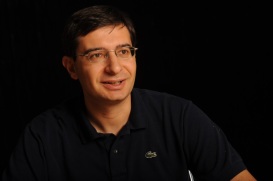BY THOMAS FARRELL on JULY 28, 2017
In a recent paper in JPhysB, published as part of our Emerging Leaders special issue, Giovanni Cirmi describes the first experimental results in the direction of a terahertz-cascaded optical parametric amplifier, a new technique which can exploit spectral cascading to generate narrowband terahertz radiation with few percent optical-to-terahertz conversion efficiency. We asked them to explain their work for us:
Free electron lasers (FELs) have allowed in the last years several discoveries in physics, chemistry and biology. FELs produce X-ray radiation emitted by electrons which are accelerated by radio frequency radiation of typically 10-cm wavelength. Due to the long wavelength of such radiation, current FELs are large scale facilities (100 m – km long) and have a high need for power or energy.
Millimeter-wave or terahertz radiation has become of crucial importance in the last decades for spectroscopy and imaging. It is natural to ask whether one can use multi-cycle terahertz radiation to accelerate electrons for table-top FELs (TTFELs) since the size of the accelerator should scale with the wavelength. TTFELs might be able to produce attosecond pulses and can be distributed to small scale scientific laboratories at much lower cost albeit also lower X-ray flux, but still sufficient for many experiments.
However, millijoule-level multi-cycle terahertz radiation is needed; therefore the scientific community has investigated methods to efficiently produce terahertz radiation with present lasers. In this paper, we review cascaded nonlinear methods that have been investigated in the past by other research groups, and introduce our idea of cascaded optical parametric amplification for terahertz generation (THz-COPA), which promises to generate the required terahertz radiation with few percent efficiency. Reaching high efficiencies is a fundamental step forward towards the construction of THz-driven TTFELs.
The work presented in the paper was mainly carried on in the Ultrafast Optics and X-rays group at the Center for Free Electron Laser Science (CFEL), led by Prof. Franz X. Kärtner. The group develops novel coherent light sources with spectra ranging from X-rays to terahertz, femtosecond and attosecond timing distribution systems for large scale FEL facilities, high-energy laser amplifiers, high-energy sub-cycle optical parametric synthesizers used in high-order harmonic generation, attosecond pulse generation, and coherent free-electron sources. These sources are applied to strong-field physics and attosecond science.
About the author:

Dr Giovanni Cirmi
Giovanni Cirmi has been working on several projects related to ultrafast nonlinear optics, the generation of carrier-envelope phase stable high-energy femtosecond visible and infrared pulses via optical parametric (chirped pulse) amplification, high harmonic generation, time-resolved femtosecond spectroscopy and coherent control. At the moment, his interests are the generation of high-energy sub-optical-cycle pulses via optical parametric synthesis and high-energy terahertz generation.
Giovanni Cirmi received his M.Sc. in electronic engineering in 2005 and his Ph.D. with honors in physics in 2009, from Politecnico di Milano, Italy. He was granted two ‘Progetto Rocca‘ fellowships at Massachusetts Institute of Technology, USA. In 2012 he joined the Ultrafast Optics group at CFEL/DESY (Hamburg, Germany), where he is team leader in the area ‘Femtosecond optics/OPAs’.



No comments:
Post a Comment